Target Localization in Underwater Acoustic Sensor Networks Using RSS Measurements
Abstract
:1. Introduction
2. The System Model
3. The Proposed Methods
3.1. Target Localization in the Known Transmit Power Case
3.2. Target Localization in the Unknown Transmit Power Case
4. Complexity Analysis
5. Cramer–Rao Lower Bound Analysis
6. Simulation Results and Analysis
7. Conclusions
8. Further Research
Acknowledgments
Author Contributions
Conflicts of Interest
Abbreviations
| UWSN | Underwater Acoustic Wireless Sensor Network |
| UWA | Underwater Acoustic |
| RSS | Received Signal Strength |
| ToA | Time-of-Arrival |
| TDoA | Time-Different-of-Arrival |
| AoA | Angle-of-Arrival |
| SDP | Semi-Definite Programming |
| Probability Density Function | |
| ML | Maximum Likelihood |
| WLS | Weighted Least Square |
| WLS-K | Weighted Least Square-Known |
| WLS-U | Weighted Least Square-Unknown |
| GTRS | Generalized Trust Region Subproblem |
| CRLBs | Cramer–Rao Lower Bounds |
| CRLB | Cramer–Rao Lower Bound |
| CRLB-K | Cramer–Rao Lower Bound-Known |
| CRLB-U | Cramer–Rao Lower Bound-Unknown |
| RMSE | Root Mean Square Error |
| Mc | Monte Carlo |
| CDF | Cumulative Density Function |
| ME | Mean Error |
Appendix A. CRLBs Deduction
Appendix A.1. CRLB Deduction in the Known Target Transmit Power Case
Appendix A.2. CRLB Deduction in the Unknown Target Transmit Power Case
References
- Akyildiz, I.F.; Su, W.; Sankarasubramaniam, Y.; Cayirci, E. Wireless sensor networks: A survey. Comput. Netw. 2002, 38, 393–422. [Google Scholar] [CrossRef]
- Garcia, M.; Sendra, S.; Atenas, M.; Lloret, J. Underwater wireless ad-hoc networks: A survey. In Mobile Ad Hoc Networks: Current Status and Future Trends; CRC Press: Boca Raton, FL, USA, 2011; pp. 379–411. [Google Scholar]
- Jaime, L. Underwater Sensor Nodes and Networks. Sensors 2013, 13, 11782–11796. [Google Scholar] [CrossRef]
- Tan, H.P.; Diamant, R.; Seah, W.K.G.; Waldmeyer, M. A survey of techniques and challenges in underwater localization. Ocean Eng. 2011, 38, 1663–1676. [Google Scholar] [CrossRef]
- Park, C.H.; Chang, J.H. Closed-form Two-step WLS-based TOA Source Localization Using Invariance Property of ML Estimator in Multiple-Sample Environment. IET Commun. 2016, 10, 1206–1213. [Google Scholar] [CrossRef]
- Kim, S.; Cho, J.; Park, D. Moving-target position estimation using GPU-based particle filter for iot sensing applications. Appl. Sci. 2017, 7, 1152–1166. [Google Scholar] [CrossRef]
- Rehan, K.; Qiao, G. A Survey of Underwater Acoustic Communication and Networking Techniques. Res. J. Appl. Sci. Eng. Technol. 2013, 5, 778–789. [Google Scholar]
- Fang, X.; Nan, L.; Jiang, Z.; Chen, L. Multi-channel Fingerprint Localization Algorithm for Wireless Sensor Network in Multipath Environment. IET Commun. 2017, 11, 2253–2260. [Google Scholar] [CrossRef]
- Hosseini, M.; Chizari, H.; Chai, K.S.; Budiarto, R. RSS-based distance measurement in Underwater Acoustic Sensor Networks: An application of the Lambert W function. In Proceedings of the International Conference on Signal Processing and Communication Systems, Gold Coast, Australia, 13–15 December 2011; pp. 1–4. [Google Scholar] [CrossRef]
- Kim, C.; Lee, S.; Kim, K. 3D underwater localization with hybrid ranging method for near-sea marine monitoring. In Proceedings of the International Conference Embedded and Ubiquitous Computing (EUC), Melbourne, Australia, 24–26 October 2011; pp. 438–441. [Google Scholar] [CrossRef]
- Yan, Y.; Wang, W.; Shen, X.; Yang, F.; Chen, Z. Efficient convex optimization method for underwater passive source localization based on RSS with WSN. In Proceedings of the International Conference Signal Processing, Communication and Computing (ICSPCC), Hong Kong, China, 12–15 August 2012; pp. 171–174. [Google Scholar] [CrossRef]
- Xu, T.; Hu, Y.; Zhang, B.; Leus, G. RSS-Based Sensor Localization in Underwater Acoustic Sensor Networks. In Proceedings of the IEEE International Conference on Acoustics, Speech and Signal Processing (ICASSP), Shanghai, China, 20–25 March 2016; pp. 3906–3910. [Google Scholar] [CrossRef]
- Wang, B.; Li, Y.; Huang, H.; Zhang, C. Target Localization in Underwater Acoustic Sensor Networks. In Proceedings of the Congress on Image and Signal Process, Sanya, China, 27–30 May 2008; Volume 4, pp. 68–72. [Google Scholar] [CrossRef]
- More, J.J. Generalization of the Trust Region Problem. Optim. Methods Soft 1993, 2, 189–209. [Google Scholar] [CrossRef]
- Tomic, S.; Beko, M.; Dinis, R. 3-D Target Localization in Wireless Sensor Network Using RSS and AoA Measurements. IEEE Trans. Veh. Technol. 2016, 66, 3197–3210. [Google Scholar] [CrossRef]
- Brekhovskikh, L.M.; Lysanov, Y.P. Fundamentals of ocean acoustics (3rd edition). J. Acoust. Soc. Am. 2004, 116, 1863. [Google Scholar] [CrossRef]
- Vaghefi, R.M.; Buehrer, R.M. Received Signal Strength-based Sensor Localization in Spatially Correlated Shadowing. In Proceedings of the IEEE International Conference on Acoustics, Speech and Signal Processing (ICASSP 2013), Vancouver, BC, Canada, 26–31 May 2013; pp. 4076–4080. [Google Scholar] [CrossRef]
- Qarabaqi, P.; Stojanovic, M. Statistical characterization and computationally efficient modeling of a class of underwater acoustic communication channels. IEEE J. Ocean. Eng. 2013, 38, 701–717. [Google Scholar] [CrossRef]
- Beck, A.; Stoica, P.; Li, J. Exact and approximate solutions of source localization problems. IEEE Trans. Signal Process. 2008, 56, 1770–1778. [Google Scholar] [CrossRef]
- Stojanovic, M. On the relationship between capacity and distance in an underwater acoustic communication channel. In Proceedings of the 1st ACM International Workshop on Underwater Networks, Los Angeles, CA, USA, 25 September 2006; ACM: New York, NY, USA, 2007; Volume 11, pp. 34–43. [Google Scholar] [CrossRef]
- Stojanovic, M.; Preisig, J. Underwater acoustic communication channels: Propagation models and statistical characterization. IEEE Commun. Mag. 2009, 47, 84–89. [Google Scholar] [CrossRef]
- Cui, J.H.; Kong, J.; Gerla, M.; Zhou, S. The challenges of building mobile underwater wireless networks for aquatic applications. IEEE Netw. 2006, 20, 12–18. [Google Scholar] [CrossRef]
- Pólik, I.; Terlaky, T. Interior Point Methods for Nonlinear Optimization. In Nonlinear Optimization, 1st ed.; Di Pillo, G., Schoen, F., Eds.; Springer: Berlin, Germany, 2010; Chapter 4; Volume 1989, pp. 215–276. [Google Scholar] [CrossRef]
- Grant, M.; Boyd, S. CVX: Matlab Software for Disciplined Convex Programming. version 2.1. Available online: http://cvxr.com/cvx (accessed on 15 September 2014).
- Sturm, J.F. Using SeDuMi 1.02, a MATLAB Toolbox for Optimization Over Symmetric Cones. Opt. Methods Soft 1999, 11, 625–653. [Google Scholar] [CrossRef]
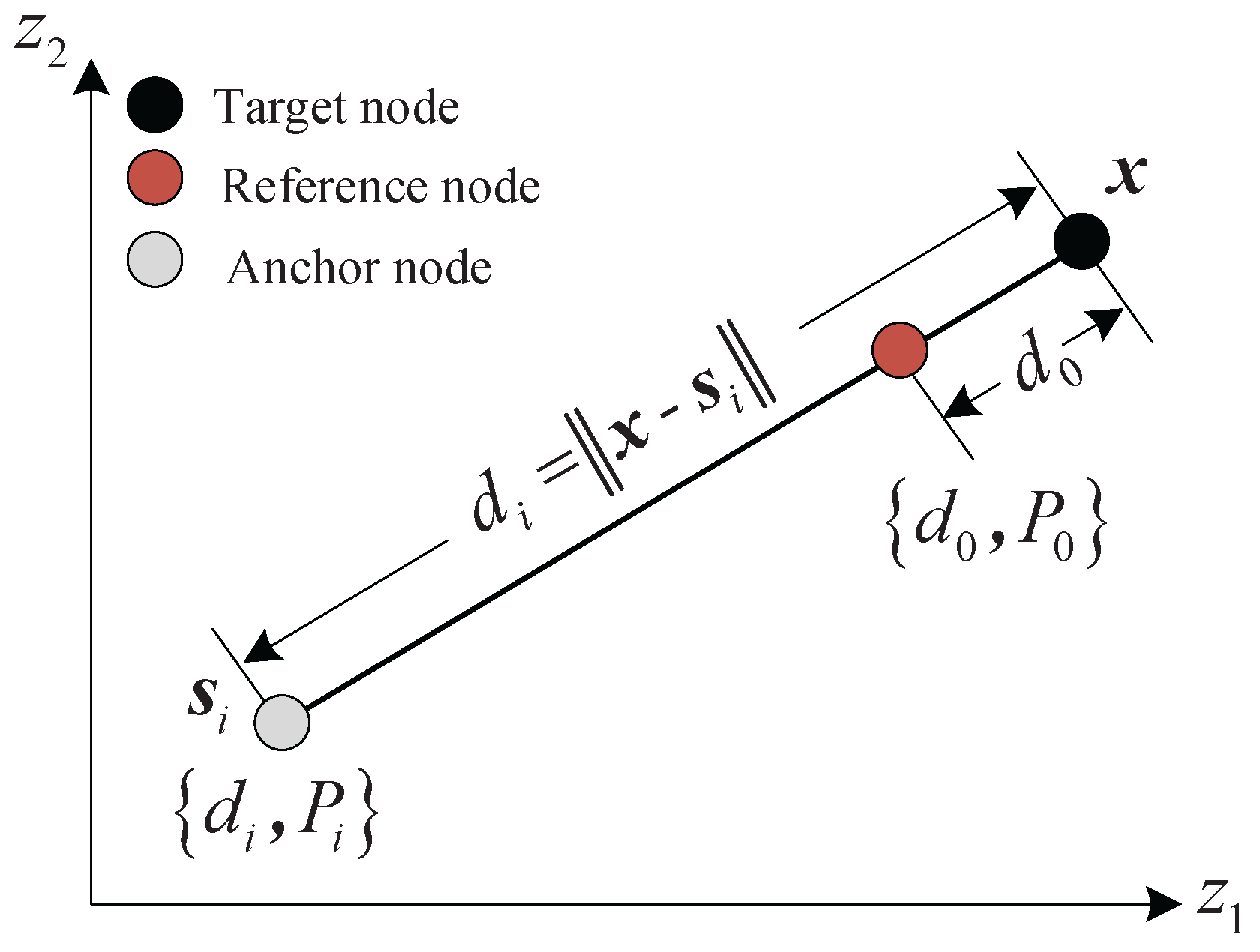

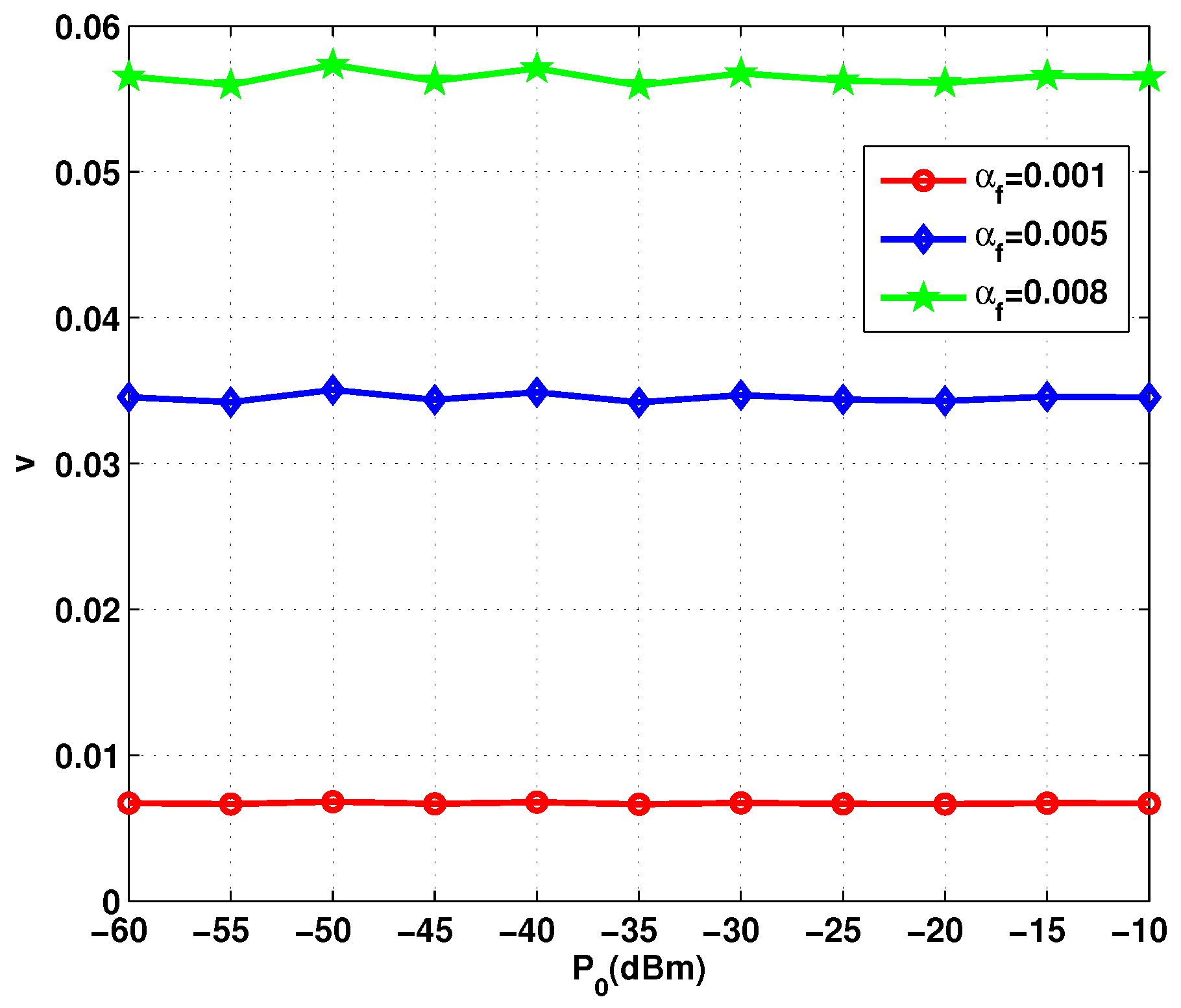
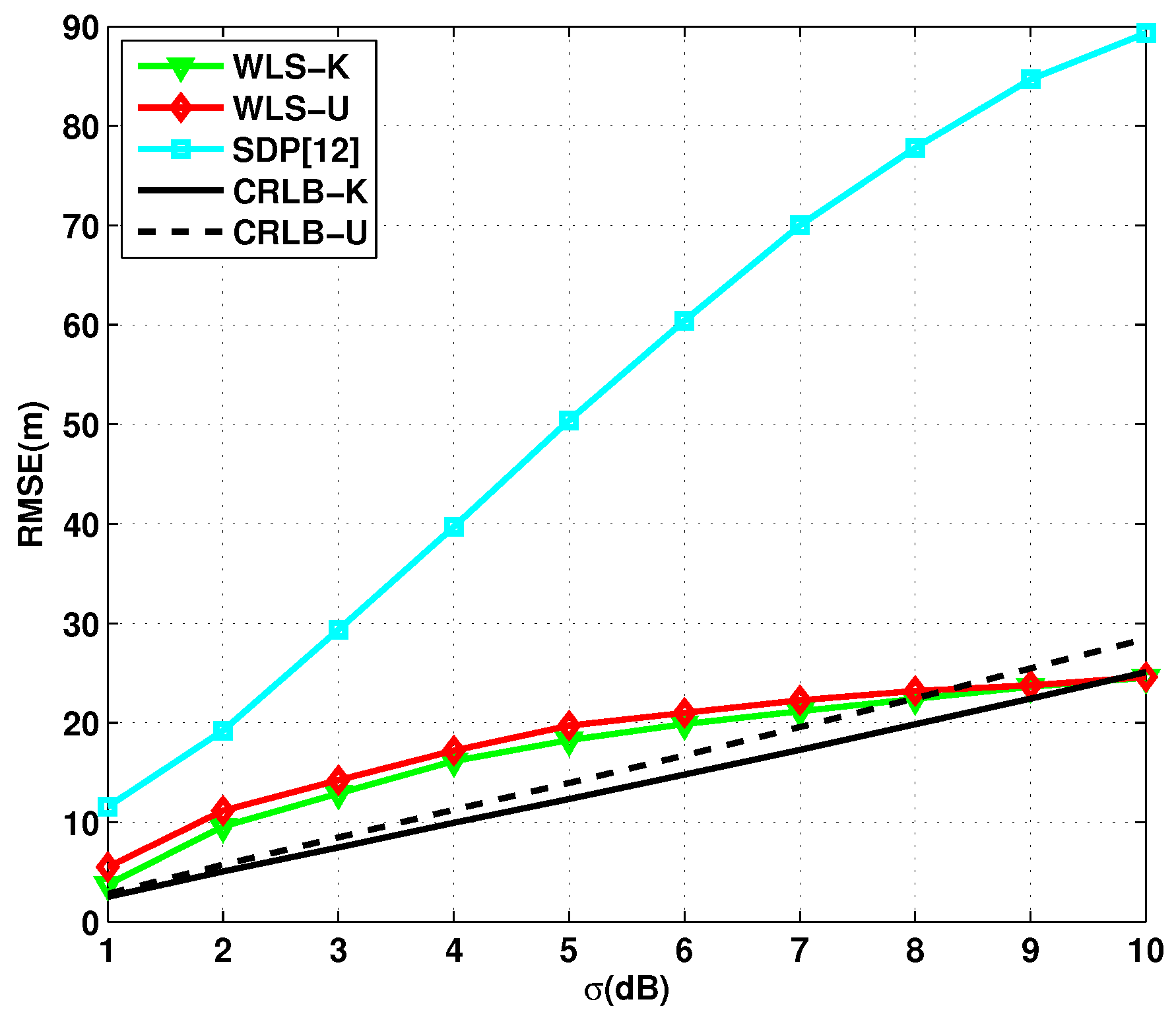

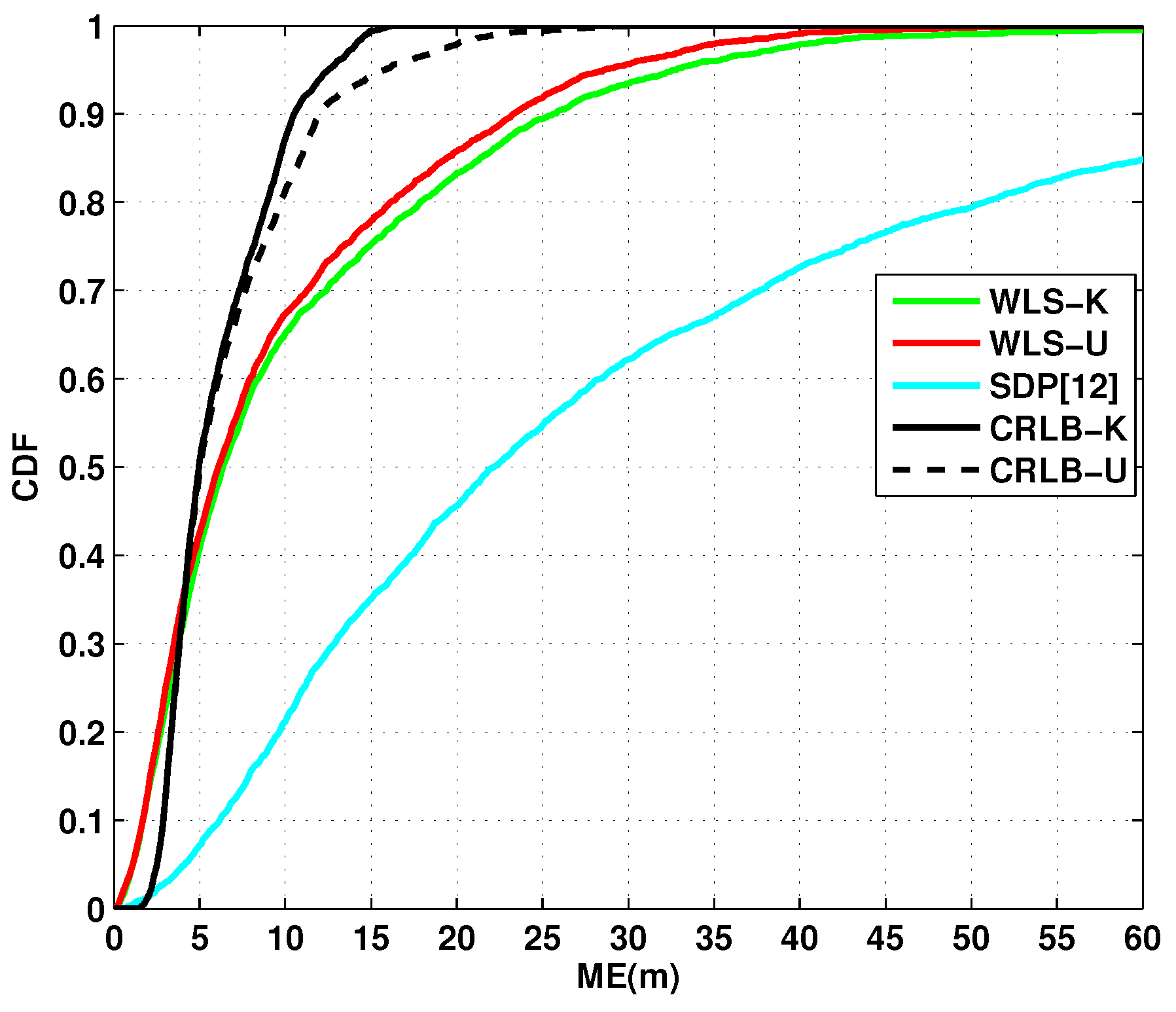
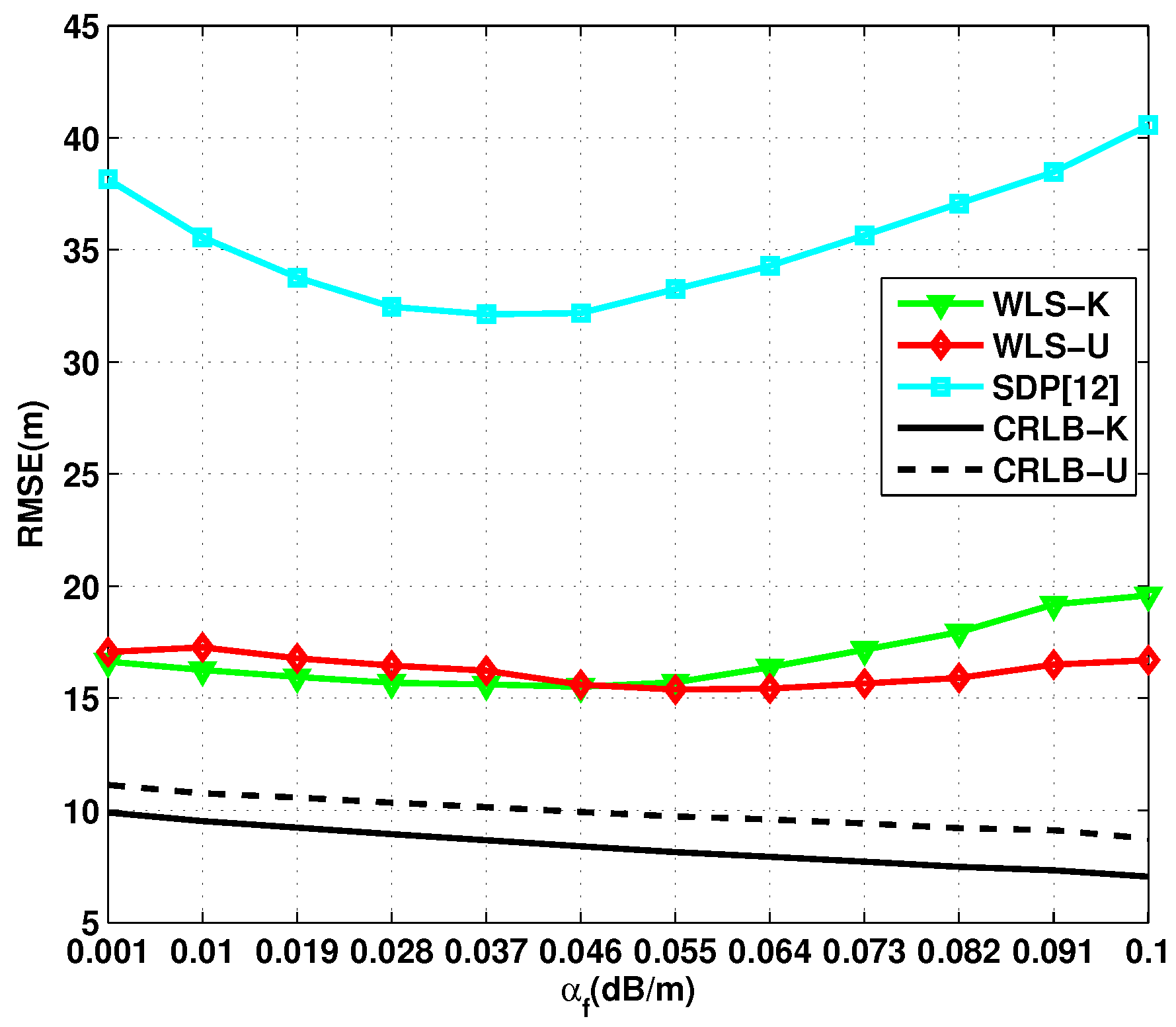
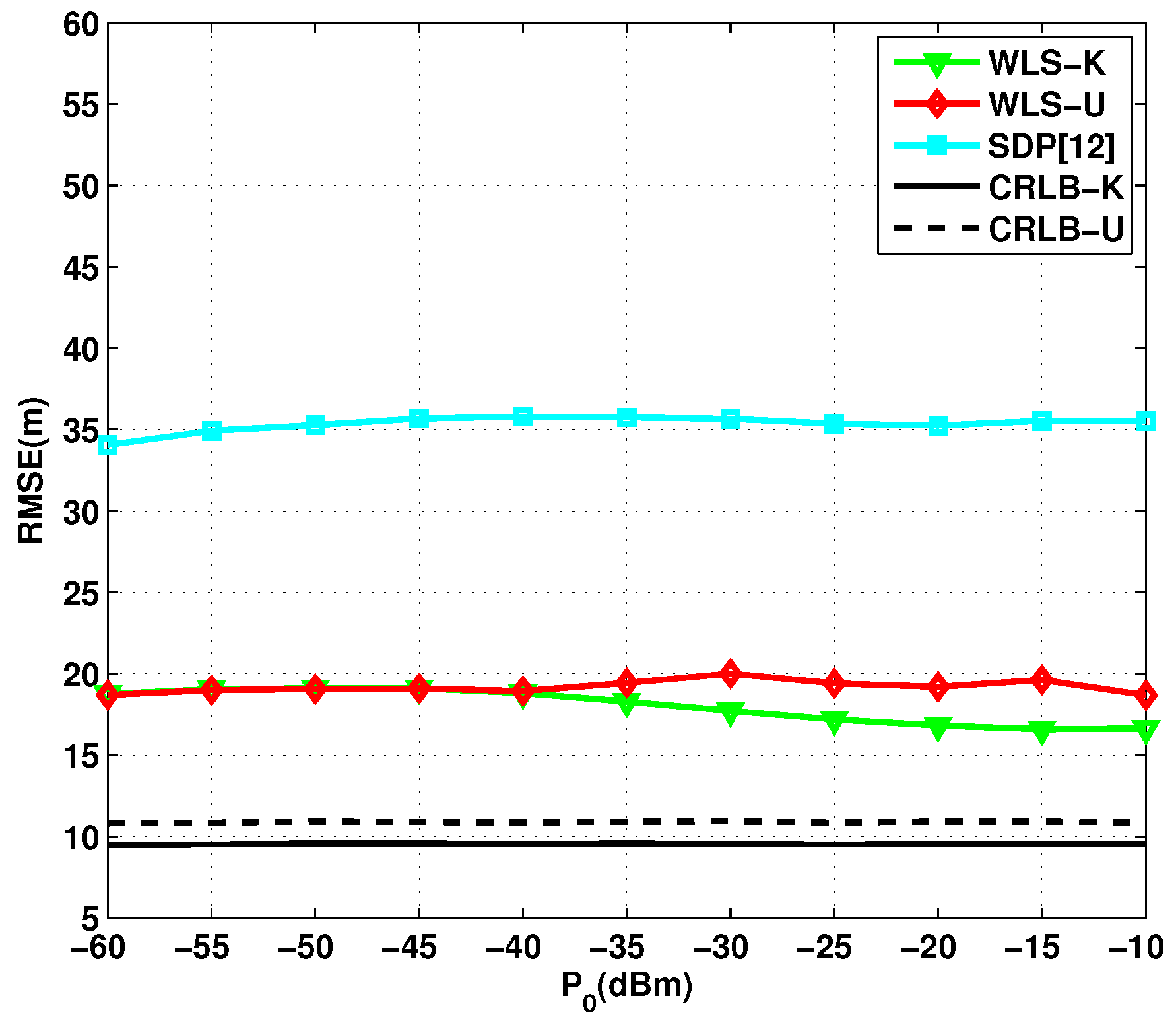
© 2018 by the authors. Licensee MDPI, Basel, Switzerland. This article is an open access article distributed under the terms and conditions of the Creative Commons Attribution (CC BY) license (http://creativecommons.org/licenses/by/4.0/).
Share and Cite
Chang, S.; Li, Y.; He, Y.; Wang, H. Target Localization in Underwater Acoustic Sensor Networks Using RSS Measurements. Appl. Sci. 2018, 8, 225. https://doi.org/10.3390/app8020225
Chang S, Li Y, He Y, Wang H. Target Localization in Underwater Acoustic Sensor Networks Using RSS Measurements. Applied Sciences. 2018; 8(2):225. https://doi.org/10.3390/app8020225
Chicago/Turabian StyleChang, Shengming, Youming Li, Yucheng He, and Hui Wang. 2018. "Target Localization in Underwater Acoustic Sensor Networks Using RSS Measurements" Applied Sciences 8, no. 2: 225. https://doi.org/10.3390/app8020225





